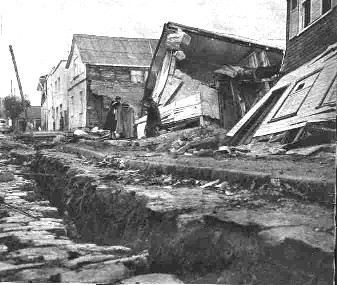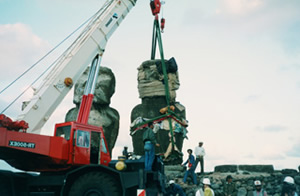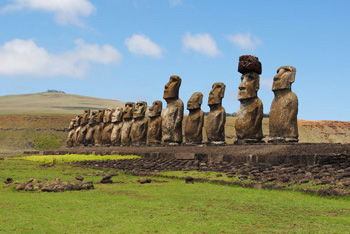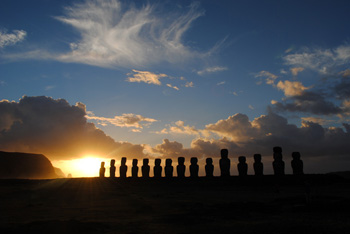
Ahu Tongariki - largest Easter Island monument with 15 moai statues
 Ahu Tongariki in 1914, before the 1960 tsunami destroyed the rock wall.
Ahu Tongariki in 1914, before the 1960 tsunami destroyed the rock wall.
With its fifteen mighty moai statues, Ahu Tongariki surpasses all other Easter Island ahu platforms and monuments in size. Thanks to Japanese donations, the ahu was restored in the 1990's. Its tallest moai, measuring 9 m, is the heaviest statue to ever have been successfully transported and placed on an ahu, with a weight of 86 tons, measured with the actual crane that performed the restorations.
The ancient tribe members of this area had the great practical advantage of being located close to the volcano Rano Raraku where the statues were made, with a distance of only 1 km from the quarry to the ahu.
Tsunami destroying Ahu Tongariki
Ahu Tongariki before the tsunami
As access to and from Easter Island in the 60's was heavily limited, those who came there as tourists often ended up staying for months. This was the case of Chilean sculptor Lorenzo Domínguez, who stayed at Rapa Nui during when the tsunami occurred. Thanks to his keen interest in photography, he has the only photo collection that shows Ahu Tongariki both before and after the tsunami.
Ahu Tongariki after the tsunami
Restoration of Ahu Tongariki
Ahu Tongariki is the biggest ahu of Rapa Nui with its impressive 15 moai statues. It contains the heaviest moai statue of Rapa Nui, with an estimated weight of 86 tons. Ahu Tongariki is located on the east side of Rapa Nui, just in front of the volcanic quarry Rano Raraku where they are made.
Tsunami destroying Ahu Tongariki in 1960
In 1960, the biggest earthquake ever recorded in the world hit Chile. As the epicenter was in the southern town of Valdivia, the earthquake was known as the 1960 Valdivia earthquake and had a magnitude of 9.5 on the Richter scale.
 Street in Valdivia after 1960 earthquake.
Street in Valdivia after 1960 earthquake.
The earthquake caused a tsunami that reached Rapa Nui. Luckily, no one died and the only archaeological site that was affected was Ahu Tongariki. Before the wave came, the statues had already been toppled, but the ahu was still quite intact. The tsunami crashed into the rock wall, destroying it. The moai statues that laid toppled in a line in front of the ahu were pushed further inland, losing some of their facial features in the process.
Restoration of Ahu Tongariki with Japanese funding
 Restoring a moai statue of Ahu Tongariki with a Japanese Tadano crane.
Restoring a moai statue of Ahu Tongariki with a Japanese Tadano crane.
In 1988, the former Governor Sergio Rapu said in an interview on Japanese television: "We've been dreaming to see the Moai standing. If only we had a crane...". Japanese crane company Tadano then decided to donate an entire crane to the island, as well as tools and expertise. The Japanese government also donated 2 million USD for the project. Thanks to these aids, the whole monument of Ahu Tongariki was restored in 1992 - 1996 (timeline at Tadano's website) under the direction of Chilean archaeologist Claudio Cristino.
In 2003, the donated crane broke down. Tadano decided to donate a new one, which arrived in 2006.
Through the close relationship established between Japan and Rapa Nui, a statue was lent to Japan for the Osaka Trade Fair. When it was returned to Rapa Nui, this moai was placed above Ahu Tongariki, just by the upper entrance to the area. It was given the name Traveling Moai, or Mōai Ha'ere Ki Haho.
Photography at Ahu Tongariki
See more photos of Ahu Tongariki.
In the morning, Ahu Tongariki is backlit, so for taking photos of the faces of the moai statues, the light is better in the afternoon. The sun starts to light up the front of Ahu Tongariki after around 12:00 - 13:00. If you're there around this time, shoot your photos standing on the left side of the monument, as the moai statues will have more light from this angle.
Ahu Tongariki is the most popular site at Easter Island for taking sunrise photos. If you have your own vehicle, you may leave town one hour before sunrise you'll be fine. Read more about Ahu Tongariki sunrise photography.
How to get to Ahu Tongariki
Follow the main road Hotu Matu'a that goes to Anakena. Passing the airport, follow the road as it curves to the left. After 2 km you will see your first road to the right. It has a sign indicating that Rano Raraku is in that direction. Turn here, towards Rano Raraku. This road will follow the south coast to the east. As you reach the east side of the island, the 15 statues of Ahu Tongariki will appear right in front of you - you can't miss it!
Visit Ahu Tongariki in a guided tour
Visit Ahu Tongariki in a guided tour to hear facts, stories and legends about this site from an Easter Island expert while standing in front of the massive statues. Book one of our travel packages with private tours included, or book our private tour Megaliths.


